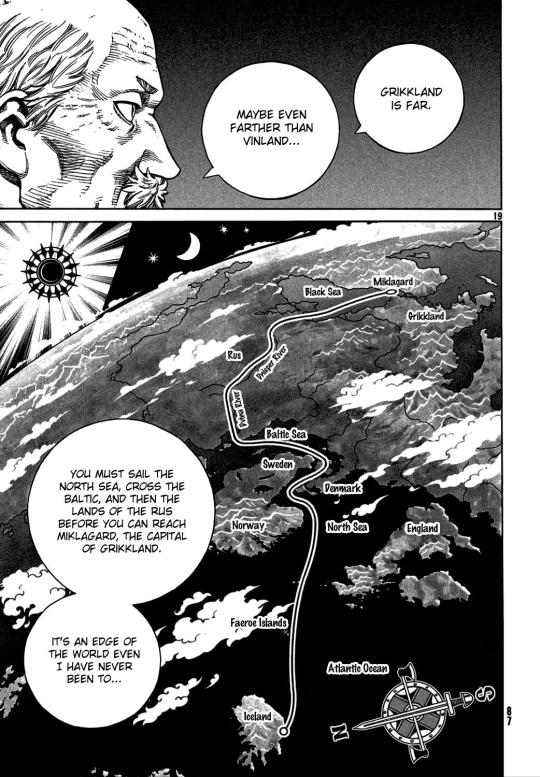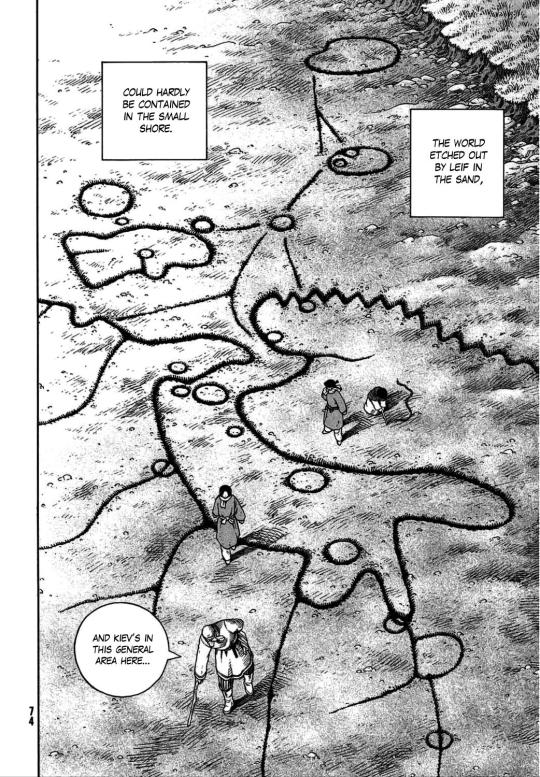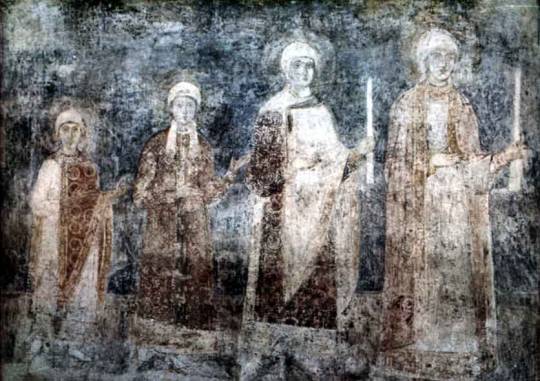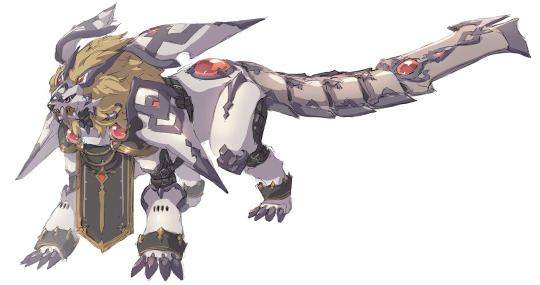#Garðaríki
Explore tagged Tumblr posts
Text
PRINCE OF GARDERIGE - RUSSIA RANDVER, KING OF THE DANES. CLAN CARRUTHERS CCIS
Prince Of Garderige-Russia Randver, King of the Danes CARRUTHERS ANCESTOR Randver was a legendary Danish king. In Nordic legends, according to Sögubrot and the Lay of Hyndla, he was the son of Ráðbarðr the king of Garðaríki and Auðr the Deep-Minded, the daughter of the Danish-Swedish ruler Ivar Vidfamne. In these two sources, Auðr had Randver’s brother, Harald Wartooth, in a previous…

View On WordPress
0 notes
Text
Offtopic: possible spoilers/teaser for future “Vinland Saga”manga chapters? Year 1019 in North/East European history

Basically, in the recent chapters of Vinland Saga the main characters have set up on a trip to Miklagarðr (Constantinople) to sell some narhval horns to the Greeks in order to raise money for their expedition to Vinland.

Well, it’s quite a detour of course and it’s, I dunno, probably somewhat a “cheesy” move, or how to put it, on author’s part,after arcs about war and thralldom, when main character finally is free and reaches his home, to make him go on a journey in opposite direction than that of Vinland where he’s to go to fulfill his dream, just to sell some stuff, but I actually liked this turn of events, and I believe it’s really justified to make the characters travel there.
Actually, it would almost be a crime not to make characters make travel there, as there was so much stuff going in those parts of the world in the time period covered by manga events, it really would be weird not to use it, and I hope you won’t find this post too long and boring to read it and see why is it so. Well, we can already see main characters having themselves caught in the middle of war in the Baltic Sea

However, as for what is going to happen on their journey next (of course if they will not find money in result of Baltic Sea war events and will continue their journey), I guess we can guess which historical events are the characters going to get involved into and what the characters are going to encounter, since we’ve seen quite a few hints already. For example, to reach Miklagarðr from Iceland they could theoretically take two routes: one is to go south and then go through Gibraltar (somewhat like Bjǫrn Járnsíða did) and after that going past Italy to reach Miklagarðr from the West. Though obviously the characters went East right away and went to the Baltic Sea, which indicates that they will likely be taking (of course if they will still be going to Constantinople) the historical trade rout “from the Varangians to the Greeks” which did actually connect Scandinavia with (Eastern) Roman Empire. Actually, as you can see on the manga page below the route the characters were planning to take has already been shown, and it has “from the Varangians to the Greeks” route as its part, where they would go from Baltic Sea along the Dnieper river (though, theoretically the still can take Dniester) South across Garðaríki to the Black Sea and from there to Grikkland.

And it’s actually quite interesting, since taking such route they will most likely visit Kænugarðr (or Kijev) along their way. The city was an important point on the trading route and (not surprisingly) an important center (if not capital, though hardly such term is 100% applicable) of Kievan Rus' (or Garðaríki) which was an East Slavic state although ruled by the rulers of the Rurik dynasty which was of Norse origin (named after its founder, who’s mentioned in Slavic sources as Rurik, but, of course if you’ve even simply watched my Dark Souls etymology videos I guess it would be quite obvious that the origin of the name is Germanic, composed of elements *hrōþiz - for loud, or rather famed, in this case, and *rīks - king, ruler, an element we’ve seen in quite a few Dark Souls names).

And it happens so that the years of the manga events (1019 in the recent chapters, possibly 1020 by the time characters would reach Kænugarðr, provided they ever will, of course) match the first years of the reign of a person known to Norse peoples as konung Jarizleifr (also I believe he was called “the Lame” for indeed it seems he used to limp) as high ruler of Kijev (the stuff I read about when working on an old Cossack cosplay video, which wasn’t even related to the cosplay in the end =/). Bascially about 50% of the name “Jarizleifr“ has no real meaning in Old Norse, since it’s just an adaptation of a Slavic name Yaroslav (from Proto-Slavic *jarъ- “furious/fierce” and *slava - “fame/glory”), with “lav” part of “slav” element broken separately and taken as “leif” or “leifr” which is Old Norse for “inhertior/heir” and of course can be seen in the name of Leifr Eiríksson who is both a historical character and one of the major characters in the manga. But, anyway, returning to the historical events which will possibly be covered in manga - the ruler of Kænugarðr in the years the manga events cover was prince Yaroslav the Wise, who himself was a descendant of Rurik and whose wife (whom he married in... 1019) was Princess Ingegerd of Sweden, daughter of king Olaf of Sweden.


And Yaroslav’s way to power as ruler of Kijev was marked by a struggle for power against his brother Sviatopolk and foreign invasions (like of Poles under Bolesław I Chrobry (the Brave) who supported Yaroslav’s rival Sviatopolk) in 1018, with Yaroslav finally winning the throne against his brother in... 1019. Although Yaroslav’s victory was only followed by a conflict against own nephew Bryachislav, whom he fought and defeated in 1020. And these historical events are actually covered in Norse sagas (well, more correctly in þættir - sort of “short sagas”) namely the story of Eymundr, which tells of a Norse konung Eymundr who, not willing to fight against king St. Olaf II Haraldsson of Norway (as Olaf began joining Norðvegr under his own rule) and hearing the news of power struggle among brother-princes in Garðaríki following the death of konung Valdemarr (prince Vladimir), leaves his homeland together with his friend jarl Ragnarr and their men (whom include not only Norwegians but also Icelanders) to offer their services as mercenaries to Jarizleifr or whoever will treat them better. Well, since it’s a Norse story, it’s somewhat hard to say how much does it exaggerate things when it tells about greedy local ruler who can’t handle anything by himself without his wise Norse wife and is several times saved by mercenary Norsemen who aid him in war against his relatives and give him wise counsel, whom he however tries to trick in times of peace when he thinks he doesn’t need them already. And eventually (although after defeating one of the “three brothers” - Burizleifr, whose name is likely derived from the name of the Polish Duke Bolesław who supported and gave army to the actual brother Sviatopolk) Eymundr and Ragnrarr leave Jarizleif to serve “third brother” Vartilafr (likely rather nephew Bryachislav whose name likely has the very same origin as such names as Wrocisław or Vratislav in other Slavic languages) and when the two armies confront each other Eymundr manages to negotiate peace between “brothers” with Ingegerd, Jarizleif’s wife. And subsequently Eymundr got lands for himself becoming a “guardian” of the local state and it’s also said that together with Ingegerd they used to solve all the serious problems in Garðaríki . So, returning to manga, Garðaríki wouldn’t really be that much of a foreign place to the heroes of Vinland Saga (well foreign, but with lots of their kinsmen involved, and I believe the inhabitants of Kijev were called “Danes” in some Western European sources at that age, apparently because the ruling dynasty there was of Norse origin), and there was really lot of interesting stuff going on historically (and described in þættir) involving Norsemen (and particularly Icelanders) in the very same years the manga covers, and that only in that one spot of the route which the heroes, it seems, are going to take. And I guess it would be strange if it’s not going to be covered in the manga. So, escaping the power struggle for throne of Denmark and power struggle within the Jomsvikings, the characters might arrive to Garðaríki to get involved in power struggle there, and who knows, maybe it will be the pacifist Þorfinnr Karlsefni of the manga who will negotiate peace between rival parties of Garðaríki conflict in 1019/1020 ? Another dimension is that Garðaríki had already adopted Christianity, but from Byzantine Empire, and although Leifr is Christian also, he’s rather a Western Christian, while the events of manga take place just some decades before the East–West Schism (which only finalized the process that had been going on for some time already), so it’s interesting if it’s going to be covered as well. But anyway, it’s only one point of the possible route, and after Kænugarðr there are Dnieper thresholds to the south with Turkic nomadic peoples ambushing the traders and so on and so forth, all the way to Miklagarðr where Roman emperors had Varangian guard and, for example, one could find some Norse Runic writings on marble parapets mentioning some Norseman Halfdan....

So the historical period is quite exciting offering lots of opportunities to make some very interesting stories, even before finally “sending” the main characters to Vinland and I’m really looking forward to see if my guesses were right or not
#Vinland Saga#Vinland#Thorfinn#Leif#Garðaríki#Gardariki#Miklagarðr#Miklagard#Constantinople#Roman Empire#Vikings#Jarizleifr#Kiev#Kyiv#Kaenugard#Lore#Yaroslav the Wise#Eymund#Ragnarr#Ragnar#Saga
49 notes
·
View notes
Note
I was wondering how you would translate the word Tyrfing/Tyrfingr, the modern name for a legendary ancient norse sword first wielded and named by the King Svafrlami Sigrlamisson of Gardariki. King Svafrlami, earliest record of mention being in the Hervarar saga from 13th century Iceland, was an ancient Germanic King thought by genealogists to have lived from 430-475 AD ruling the kingdom of Gadariki. So the most accurate translation that Svafrlami himself used would be in Germanic Elder Futhark?
You might already know this, and are just presenting it this way for simplicity and for helping to identify what you're talking about, but it's probably a mistake to treat Hervarar saga as a faithful report about historical events. Its accuracy is probably comparable to Vǫlsunga saga. The history of the Burgundians is better known than the events that would go on to underlie Hervarar saga, and a comparison of that to Vǫlsunga saga makes it very clear that the saga is not a reliable witness. For one thing, Garðaríki was not a historical kingdom in the time described by Hervarar saga, and is probably supplied by the saga compilers because their then-current idea of it corresponded more or less well to the geographical location of the events under discussion.
Anyway, the actual answer here is unclear, because the etymology of Tyrfingr isn't known. The primary theories are that it's related to (or literally the same word as) the Tervingi, an East Germanic people whose context was similar to that of the setting of Hervarar saga; and that it's related to torf, 'turf,' referring to it needing to be retrieved from underground. If the former is true, then it is actually more etymologically accurate to write it "Tyrvingr" (which does occur; but by the time it was written down there was no longer any difference between "Tyrvingr" and "Tyrfingr" in the Icelandic of the time, so that doesn't tell us anything).
If the former, then we would want to reconstruct Tyrvingr to something like *Terwingaʀ (ᛏᛖᚱᚹᛁᛜᚨᛉ) in Elder Futhark-era Proto-Norse. This is a little bit problematic -- we'd be more likely to see that develop into Old Icelandic as **tjǫrvingr, but there's also no really compelling reason to assume that it would have been loaned directly into Proto-Norse, and then followed a normal path of development from there. It's entirely possible it could have been loaned into North Germanic from and East or West Germanic language, and it would hardly be possible to say how that would effect its eventual Old Icelandic attestations.
If it's built on the word torf 'turf,' that is much more straightforward: the hypothetical Proto-Norse would be *turbingaʀ (ᛏᚢᚱᛒᛁᛜᚨᛉ).
However, Svafrlami, if this corresponds to a real historical figure, would not have spoken a language written in Elder Futhark; he would have spoken Gothic, or something much like it. This is a bit outside my expertise, but I believe these would correspond to something like:
*terwingaz > *tairwiggs 𐍄𐌰𐌹𐍂𐍅𐌹𐌲𐌲𐍃
*turbingaz > *taurbiggs 𐍄𐌰𐌿𐍂𐌱𐌹𐌲𐌲𐍃
(Note that in Gothic, "gg" is like writing "ng," like in Greek).
Hope that helps. Tumblr crashed twice while I was typing this so if something seems disjointed it might be because of that, feel free to let me know.
7 notes
·
View notes
Note
Hello! I was wondering about the Rus portrayed in Vikings. First of all weren’t the Rus not fully Christianized until the 10th century & second weren’t the majority of the Rus Vikings from Sweden not Norway. I’m just confused because Oleg in the show says he wants to take back his ancestoral home. 🤔
Thanks for the question! 💙❤️💚 You are correct on both actually, which is why the current storyline has me so rattled and infuriated... One report claims that Olga of Kiev brought most of the Rus under the Christian faith in the year 912. Some suggest that they “styled themselves as Christians” before that time but Olga was the one who ultimately brought about the large scale conversion.
And yes, the Rus were primarily Swedish vikings. (What’s really irritating is I just went to research for this post and all I typed was “When did the Rus” and a bunch of “When did the Rus conquer Scandinavia/Norway” suggestions popped up and I just can’t..) But yes, my mother actually has a lot of Swedish ancestry and many of them migrated to Ukraine and near modern day St. Petersburg. Norwegians focused on the western side of the world(The British Isles, Iceland, and Greenland while the Swedes focused more on the east. I’m sure there were some Norwegian and Danish vikings in the Kievan Rus, and most definitely the Varangian Guard. There was actually a law set in place that if you wanted to join the Varangian guard, you might risk losing your inheritance because of how many had left to join. There’s a lot of history and I get that Hirst had to simplify some of it, but I’m just upset because his writing is being taken so literally and people think he’s telling a real life story.
Also, if Hirst cared for Hvitserks character- Hvitserk should have been apart of establishing the Kievan Rus as he is one of the alleged sons of Ragnar that did end up in the lands of the Rus(known as Garðaríki) and some even link him as the father of Askold or as Askold himself. Blurry history, but this would have been such an epic story and it would have mirrored real history a bit more.
#vikings#kievan rus#vikings history channel#history#oleg the prophet#prince igor#ivar the boneless#hvitserk
26 notes
·
View notes
Note
I do not mean this in a negative way or is in no way criticizing you. I’ve just kind of noticed that somethings you add in your stories is before their time. It mainly small details such as Viking women wearing corsets, which as far as we know, they didn’t. Not a lot is known or at least completely confirmed during that time period so obviously you need to fill out. And of course you have the right to creative freedom when you write fiction. This was just something I have been thinking of.
Well, I've never written any of my characters as Heathen women. 🤔 Readers have always been Christians, foreigners or from faux Christians lands. The only half Heathen is in White Lies.
As with most writers, I do a great deal of research despite writing fiction. So here are some facts for you:
Historians are unsure if women wore hard stays (corset) in the early Medieval days or not. But light corsets and bodices were worn. They were made out of leather, linen and such fabrics and were sometimes stiffened with busks of wood or whalebone. Sometimes it was sewn directly into the garment or dress.
Furthermore, Fashion History reveals the first recorded corset originated from Crete in Greece, worn by the Minoan people. This was during Antiquity which is BEFORE the Middle Ages.
Images on ancient pottery show both WOMEN and MEN sporting form fitting belts and vests with leather rings or straps that constrict and shape the waist.
Source

Here are just a few of the inaccuracies from Vikings. A show that has an actual paid research team:
1. Rollo And Ragnar Probably Never Met And Were Definitely Not Brothers.
2. Vikings Didn’t Call Each Other “Viking”
3. Lagertha Wasn’t As Badass As The Series Portrays Her. The whole concept of the “shieldmaiden” is based on Scandinavian folklore and myth, since there’s not even a single credible source that proves the existence of a group of Viking women who had chosen to fight as warriors. Sure, there’s archaeological evidence that proves a number of women took part in some raids and battles, but this was a rare occurrence, and most historians speculate that their role in battle was limited.
4. Viking Clothing In The Show Is Completely Wrong historians and researchers examining the evidence usually come to different conclusions. However, they would all agree that the Vikings didn’t dress with the kind of leather biker outfits that the show often depicts.
5. According To The Show’s Timeline Ragnar Should Have Invented Time Travel
6. Christians Didn’t Use Crucifixion As Punishment Or Execution
7. Soldiers Of Wessex Wear Italian Helmets Seven Centuries Ahead Of Their Time
8. The temple to Odin at Uppsala. The Historic temple was actually one of many stave churches and a hallmark of Christian architecture from the 11th Century onward.
9. King Alfred Was No Bastard And Had Three Elder Brothers. All Whom Ruled As King
10. There Was No "Judith". There Was Osburh And She Was No Whore. She was the mother of all of Athelwulf's children. Judith was a second wife down the line and never met Ecbert.
11. Saint Ansgar Is Depicted As A Failure In The Show (Which Was Not The Case At All)
12. Bizarre And Impractical Hairstyles, shaven heads and superabundance of tattoos, it would appear that great liberties have been taken with actual Viking culture and history.
13. Anachronisms Abound. Many of the Vikings are depicted as shaving their heads, including Ragnar, who apparently has his head covered in tattoos. There is no historic evidence that Vikings did that. Anyone who has lived in Scandinavia would be aware of the incredibly biting cold. To deliberately remove the hair from ones’ head when living in often icy conditions and sailing the open seas, would be insane.
14. There Is No Russia. The country did not exist under that name during that time period. Instead, the Old Norse term for that area would have been "Garðaríki". At the time, the future country was nothing more than a collection of cities.
🤘 Sources: Dr. Peter Hammond, Theodoros Karasavvas and The Ancient History Encyclopedia.
12 notes
·
View notes
Text
Tyrfingmon

Tyrfingmon [ティルヴィングモン] Name origin: ‘Tyrfing’ is a sword from Norse mythology which was cursed to kill whenever it was drawn, always result in a lethal wound, and be the cause of three great evils. Level: Ultimate Attribute: Virus Family: Metal Empire, Nightmare Soldiers, Virus Busters Type: Weapon
Description
Tyrvamon’s true form, which it attained after it had finally dispelled the curse placed upon it. Now free from its quest to undo its curse, Tyrfingmon seeks a comrade-in-arms whom it shares the same ideals with to join their cause. However, it still takes a long time to warm up to others and does not like being with a large group. As with all Weapon Digimon, its true potential lies in its ability to transform, and it is said to bring victory to those who wield it in battle. However, it emits a strong amount of dark energy even in weapon form, causing all but the most strong-minded of wielders to go crazy should they try to wield it. Its purified armour repels all dark-elemental attacks, and the four armour plates surrounding its torso can freely move to parry and deflect attacks. It is not a fast runner due to its immense weight; this is also carried over to its weapon form, requiring its wielder to possess considerable physical strength.
Attacks
Garðaríki Fort (ガルザリーキフォート): Spreads its armour plates out, forming a small barrier that nullifies attacks. It is most effective on attacks aimed at Tyrfingmon head-on, but its effectiveness drops off quickly otherwise.
Empress Order (エンプレスオーダー): Shrouds its blade-like tail in dark energy and slashes the opponent.
Myrkviðr (ミュルクヴィズル/Old Norse: Dark Forest): Lets out a roar and consumes the surroundings in a field of complete darkness, causing the opponent to lose their bearings. It can then make spikes manifested from dark energy appear anywhere that is covered by darkness.
Evolution Line
Kojimon > Karumon > Svermon > Hrottimon > Tyrvamon > Tyrfingmon
105 notes
·
View notes